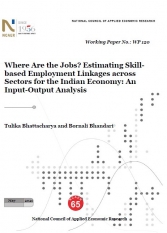Where Are the Jobs? Estimating Skill-based Employment Linkages across Sectors for the Indian Economy: An Input-Output Analysis
Bornali Bhandari
Tulika Bhattacharya
May 2021
The Economic Surveys (2014–15 and 2015–16) have, over the years, stressed on the need to create jobs to meet the needs of a burgeoning population. However, the question as to which sector has the most potential to create jobs and at what level have often been left unanswered. The objective of this paper is to identify the sectors of the Indian economy that are able to generate different types of skilled employment, both directly as well indirectly, by estimating their employment linkage effects with varying levels of skills using the Input–Output technique. The contribution of this paper is that it re-defines skills by combining three types of education, including general, vocational and technical education, and thus defines four types of skilled employment categories—low skilled, low-medium skilled, medium-high skilled, and high skilled employment. The paper incorporates these four types of skilled employment within the Input–Output framework, using the World Input–Output Database (WIOD), and estimates the forward and backward linkage effects related to employment with respect to four different skill types for India. The estimation of these employment linkage effects is critical to identify the key employment-generating sectors in the Indian economy with varying levels of skill.
The study also urges policymakers to boost some select sectors in order to enhance different types of employment, thus proposing a way to take forward the ‘Skill India Mission’.
National Growth and Macroeconomic Centre







